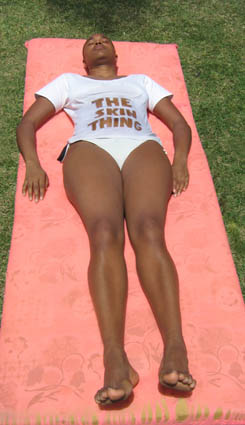
Expositions du 23/03/2006 au 29/04/2006 Terminé
Galerie Les filles du calvaire 17, rue des Filles-du-Calvaire 75003 Paris France
I am upset by the one-sided view of Africa that the media is constantly spreading in a diverse manner. One gets the impression that Africa is a poverty-stricken, disease-ridden continent with a confused post-colonial society, generally corrupted political systems and chaotic non-functional economical and infra structures. The global trend towards informing the public of war, conflicts, crisis' and critical social issues results in limited impressions of certain places, if one is to hear nothing more of them in other contexts. Thinking of Ethiopia, we think famine. Thinking of Rwanda, we only think war. At the mention of Africa, are we soon only to think AIDS?
Alone the terms underdeveloped, developing countries and third world strictly suggest the inferiority of the countries so called, which are considered to be lacking the development, the standard of living, the achievements and goals set by the western world. Within African states themselves there is a tendency to strive towards the American and West-European way-of-life, which itself is becoming increasingly questionable.
In the same way that media and public opinion seem to circle around the negative aspects of African conditions, it might be interesting to adapt the same strategy to western cultures. If one was to depict a parallel impression of the western world, by concentrating on the negative results of the processes of civilisation, it could be something like the following.
The development of the western world in the past decades and centuries has obviously led to a decay in values and the loss of spirituality, which occurred due to the fact that money, power and property have become more important than people and personal relations. One could even speak of a loss of humanity, as the inhabitants become more selfish and uncaring about their fellow citizens, their main interest being to achieve material wealth. Family structures are increasingly deteriorating, leaving the youth with little guidance and support and lacking orientation. Too-much-of-everything, loss of meaning, over-weight and sickness due to over-consumption, mental diseases arising from loneliness and emotional isolation are problems which western societies are facing. The situation seems to be heading towards a cultural burnout syndrome.
If such one-sided views were to be systematically conveyed by the media throughout the world, the inhabitants spoken of would surely begin to feel very sorry for themselves, while people of other cultures would have a chance to begin to feel superior. This is a negative example of how to change an imbalanced situation, but it is naturally not the approach that I as an artist would suggest.
From the beginning it was a very negative image of Africa and Africans that was spread by the European conquerors in order to justify slavery and colonialism. Bringing to mind the history of distortion and falsification arising from the ideology of racism, we should question whether centuries of the established attitude has not left it's mark upon us all, influencing relations between African people and people from Western societies on all different levels of interaction, be it of political, economical or social nature. Until today there have not been sufficient official apologies for the history of events that has taken place in Africa. Let us not forget that it was only recently that the last regime of White-minority rule in Africa was officially ended. This does not mean that the mentality of the people who lived within that system has been changed over-night.
The continuing reports of racist behaviour throughout Europe and America make it obvious that we have not overcome the history that began as the need to suppress and exploit a whole culture to satisfy the economical and power-hungry needs of another.
To go one step further: Could it be that the negative image of Africa is in fact being kept alive through the use of a new system of one-sided information, wrong interpretation and judgement, and this in order to achieve new justification for the imbalance?
From the point of view of many African artists there is an understandable need to speak about problems and pains, which in part probably arise from the history of colonialism. Some artists reflect and artistically document crimes of war and atrocities of violence, which have happened or are going on in their countries. I too have dealt in my work with the topics of discrimination and violence against black people in history and now.
At this point, I feel the need to search for images that could speak about hope, strength and continuity. With the video installation Dressed like Queens I am attempting a strategy of artistic defence.
The work concentrates on depicting the strength, creativity and potential power of African people and especially of the African woman symbolizing motherhood and creation.
To learn and borrow from the power of tradition and the rituals of my African ancestors and relations it was necessary to research on the values and customs of my tribe as well as of other tribes in Africa, in the past and today. The general approach to life, music, dance, creativity, but also to illness and death, including topics such as communal behaviour, the stages of maturity and the various ceremonies concerned with initiation were of interest to me.
Working with myself and another woman of colour on articulating our personal histories and experiences through gestures and individual movement, I was intent on revealing strong presence and expression of pride.
In the resulting installation videos are projected in large dimensions onto a triptych of colourful hand-dyed fabrics. The central figure is a pregnant woman, observantly recorded by the camera as she sits, stands and moves in a slow majestic manner. Flanking her, on the complementary colours red and green are projections of myself, gesturing expressively while speaking a poetical text of my own. The narration tells about women, my metaphorical queens, whose clothes have been taken away from them, and how, after difficulties and troubled times, they finally reclaim their rightful property.
My attempt is to find an authentic expression of Self, which reflects the lives of women of African heritage today. The piece has ritualistic qualities, of a kind one has not come across, as they are newly constructed from individual histories.
I act out a body and voice performance titled Reclaimed in dialog with the installation, picking up on the idea of dressing as an act of communication and an expression of identity. The performance incorporates painting on the skin, using red Kenyan earth to mark certain parts of my body in simple self-invented patterns. Finally, I engage in an expressive and personal way of singing and using my voice, to reflect the power and beauty I feel when 'thinking African'.
© Ingrid Mwangi, 2003Galerie Les filles du calvaire 17, rue des Filles-du-Calvaire 75003 Paris France

